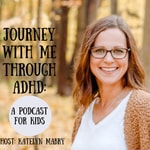The ADHD Smarter Parenting‘s Podcast – Détails, épisodes et analyse
Détails du podcast
Informations techniques et générales issues du flux RSS du podcast.

The ADHD Smarter Parenting‘s Podcast
ADHDSmarterParenting
Fréquence : 1 épisode/6j. Total Éps: 213

Classements récents
Dernières positions dans les classements Apple Podcasts et Spotify.
Apple Podcasts
🇨🇦 Canada - parenting
26/07/2025#72🇬🇧 Grande Bretagne - parenting
01/07/2025#75🇨🇦 Canada - parenting
27/06/2025#71🇨🇦 Canada - parenting
26/06/2025#80🇨🇦 Canada - parenting
20/06/2025#73🇨🇦 Canada - parenting
17/06/2025#99🇨🇦 Canada - parenting
08/06/2025#63🇬🇧 Grande Bretagne - parenting
11/05/2025#98🇬🇧 Grande Bretagne - parenting
29/04/2025#76🇬🇧 Grande Bretagne - parenting
28/04/2025#77
Spotify
Aucun classement récent disponible
Liens partagés entre épisodes et podcasts
Liens présents dans les descriptions d'épisodes et autres podcasts les utilisant également.
See all- https://club.smarterparenting.com/
124 partages
- https://www.commonsensemedia.org/
83 partages
- https://amzn.to/2Mxpsvc
3 partages
Qualité et score du flux RSS
Évaluation technique de la qualité et de la structure du flux RSS.
See allScore global : 37%
Historique des publications
Répartition mensuelle des publications d'épisodes au fil des années.
Ep. #211: We Are Making Changes to Serve You Better
Épisode 214
jeudi 8 décembre 2022 • Durée 01:27
Ep #210: Disciplining Your Child Calmly and Effectively
Épisode 213
mercredi 23 novembre 2022 • Durée 20:08
There are so many skills that contribute to managing your child's behavior. One that often stumps parents is what to do the moment your child acts poorly. The skill of Correcting Behaviors is built to support that. You can access free tools and resources to help you use this skill our website www.smarterparenting.com
Ep #201: New Challenge: Electronics and Children
Épisode 204
mercredi 14 septembre 2022 • Durée 15:10
Siope discusses the new challenge for parents that previous generations of parents have not had to deal with, namely, electronic devices. More and more children are acting out when asked to stop using electronic devices. What can parents do to help their children navigate their use of devices and the need for a positive environment in the home? Using the skill of Decision Making, parents and children can learn how to set up productive ways to work through the challenges of children using electronic devices.
Ep #113: Why the Teaching-Family Model creates lasting change
Épisode 115
mercredi 9 décembre 2020 • Durée 41:00
Understanding how the Teaching-Family came about and how it's been used to change children and families helps parents better understand the Teaching-Family Model's power in their lives.
In this episode, Eric Bjorklund, President of Utah Youth Village, talks about how the Teaching-Family Model came to be, the research that's gone into proving its effectiveness, and how it's used worldwide. He shares stories of how he's used the Teaching-Family Model as a dad and the difference it made in his relationships with his kids, and the success that Utah Youth Village has witnessed.
Smarter Parenting is a division of Utah Youth Village and was created to help families worldwide access the power of the Teaching-Family Model.
The Teaching-Family Model was developed in the 1960s to deal with children who had challenging behavior. The researchers found that they could teach children how to be successful long-term by teaching them specific behavioral skills that allow them to learn, grow, and change. By focusing on the good a child is doing, you will start to see incredible results.
Since the 1960s, the Teaching-Family Model been used by agencies, schools, and parents worldwide to address all types of behavior.
The Teaching-Family is not only for kids with problematic behaviors; any child and family can benefit from using the behavior skills you will find on SmarterParenting.com.
The success of the Teaching-Family is due to its focus on relationships and helping the child do better by teaching them what they should do and allowing them to change.
For a short video of the history of the Teaching-Family Model, watch this video.
For more information on the Teaching-Family Model, we hope you'll check out the resources available on SmarterParenting.com.
For help implementing the Teaching-Family Model in your family, sign up for parenting coaching.
Ep #112: Creating family routines that work
Épisode 114
mercredi 2 décembre 2020 • Durée 34:40
Creating family routines that work are tricky enough during the best of times. With the constant changes to work and school schedules brought about because of the pandemic, it can be hard to feel like you're finding a routine that works for your family.
When determining a schedule, take into consideration the needs of your family and their personalities. Does your family do better on more or less structure? Do your kids do better when given some freedom? Are they more of a morning or an evening person?
Understanding your family's needs will help you create a schedule that works for how your family functions. If your family likes a lot of structure, a routine with very little structure won't be effective.
Because of the different needs of your family, you may need multiple schedules. That's okay. The purpose of a family routine is to help each family member in a way that works for them.
Don't feel guilty if your family routine doesn't look like popular routines. It's okay to have more or less structure than someone else or do things differently. Remember, no routine will be useful if it doesn't make sense for your family.
Helping your child understand the routine and what is expected of them is crucial in making that routine work. The behavior skill of Preventive Teaching helps you do just that. When a child understands what is expected of them and how they need to respond to certain things, they are more likely to do it independently.
You can find the behavior skill of Preventive Teaching on the Smarter Parenting website.
Don't forget to join the Smarter Parenting Club. You will have access to incredible parenting resources that will help make your life easier.
Ep #111:Why consequences aren't working
Épisode 113
mercredi 25 novembre 2020 • Durée 33:28
Have you ever given a consequence that hasn't worked? We know we have.
Implementing consequences that work to change behavior can be difficult for many parents. Often, we continue to give consequences repeatedly that don't work, which only increases our frustration level.
Learning how to give consequences that work is made easier when parents use Effective Negative Consequences. Effective Negative Consequences gives parents the 5 elements they need to make a consequence work for their child.
Giving consequences that work is difficult because no two children or situations are the same, even though we often treat them the same.
Parents may struggle with consequences because consequences are often given as an emotional response where "grounding them for a year" seems like a good idea. Consequences given as an emotional response don't tend to be as effective because they are often too big.
When you give consequences that are too big for the behavior, often you aren't able to follow through. That teaches your child that their negative behavior doesn't matter as they will not truly get a consequence for their behavior. Which only leads them to repeat the action.
When parents use the five elements of Effective Negative Consequences, it signals to their child a few things.
First, it signals that you are disappointed in the behavior and not in them. This distinction is crucial as it allows you to strengthen your relationship even when you're giving them consequences.
Second, it allows them to see that you value them as a person. When you give tailored and essential consequences to your child, you are signaling that they matter to you.
Third, it helps them know you're interested in helping them change and be better. The purpose of a consequence is to teach and not to punish.
If you need additional help learning how to give consequences that work, sign up for parenting coaching. Both the gold and platinum tier of the Smarter Parenting club provides coaching.
Ep #110: Anxiety management strategies for kids
Épisode 112
mercredi 18 novembre 2020 • Durée 25:02
SUPPORT THIS PODCAST. JOIN THE SMARTER PARENTING CLUB SILVER TIER.
Children with ADHD often deal with other issues, including anxiety. The combination of both ADHD and anxiety can make it doubly hard for them to effectively handle situations where they're expected to behave a certain way.
Teaching them anxiety management strategies allows them to plan for and deal with situations in a way that reduces their anxiety. Anxiety management strategies don't have to be complicated. The most successful calming strategies are those that your child can do no matter the situation.
Some calm down strategies include breathing techniques, visualizing feelings, and physical grounding.
When teaching them calming techniques, it's essential to work with your child and model what you would like them to do. By modeling what they need to do, your child understands what is expected, removing confusion.
Using the ABC's of Behavior, you can find ways to address situations before, during, and after. The more you can help your child address situations early using anxiety management techniques, the more successfully your child can handle their anxiety.
You can find the ABC’s of Behavior on the Smarter Parenting website.
If you need additional help dealing with your ADHD child’s anxiety, sign up for parenting coaching. Both the gold and platinum tier of the Smarter Parenting club provides coaching.
Ep #109: Individualizing rewards and consequences
Épisode 111
mercredi 11 novembre 2020 • Durée 35:37
As parents, we want things to be fair when we give rewards or consequences. Fair does not mean the same, however, as no two children or situations are.
Individualizing rewards and consequences improves their effectiveness as it shows your child that you are interested in what they value. It also makes sure you're giving a reward or consequence that matters to your child. For example, one child may see not playing with friends as a consequence, where another might see that as a reward.
If the reward or consequence doesn't matter to your child, it will not help them learn.
The goal of rewards and consequences is to teach your child what you expect. They should never be used to punish your child. Punishing always goes to the extreme, which is less effective than starting small and adding consequences as needed.
When you focus on teaching your child, it helps your child move forward and know what to do next time. This knowledge increases their self-confidence and ability to make wise decisions.
Giving rewards and consequences that are different can be a struggle. By following the five components of Effective Positive Rewards or Effective Negative Consequences, you are better able to find individualized solutions that work for your child.
You can learn more about Effective Positive Rewards or Effective Negative Consequences at Smarter Parenting.
Ep #108: Being more effective when giving consequences and rewards
Épisode 110
mercredi 4 novembre 2020 • Durée 22:31
Giving more effective consequences and rewards require parents to understand the difference between values and interests.
Values and interests are separate and serve different purposes, especially when helping change your child’s behavior using either Effective Negative Consequences or Effective Positive Rewards.
Values are what you believe and what you want your child to learn—things like confidence, hard work, honesty, kindness, and integrity. Interests are things that you like to do—such as playing sports, music, or travel.
Parents should use interest to help teach values when giving an Effective Negative Conseqeunces or an Effective Positive Rewards. For example, parents can use the interest of time with friends to teach the values of purpose, hard work, honesty, accountability, or responsibility. By combining both values and interests, you will be more successful.
Effective Negative Consequences and Effective Positive Rewards are two sides of the same coin and can both be used to change behavior. Which one to use will be determined by what you need to teach. For some situations, a consequence may be the best course of action for a particular behavior. For many children, though, Effective Positive Rewards are more effective in changing behavior than consequences. Many children may be more motivated to earn extra time if they come by curfew than by losing time if they’re late.
It’s essential to sit down and evaluate the values you want to teach your children, as this will give you a better game plan for using their interests to do so.
If you’re struggling with using interests to teach values, we recommend joining the gold or platinum level of the Smarter Parenting Club. Both of those levels allow for coaching and individualized help and solutions.
Please help us continue to provide this podcast. Donate or join the Silver level in the Smarter Parenting Club.
Ep #107: How to communicate with those you disagree with
Épisode 109
mercredi 28 octobre 2020 • Durée 42:26
If there is one podcast we recommend listening to in the wake of what is going on globally, this is it.
We hope you will share it once you have listened to it.
Many have lost the ability to discuss topics they feel strongly about with someone who doesn't share their viewpoint without it turning ugly. Cancel culture, name-calling, fear of retribution, and lack of civility are alive and well.
This lack of civility is dangerous because it doesn't encourage growth or moving forward. Instead, we become even more passionate about what we believe.
We don't have to agree with someone, but we can learn to communicate openly and safely that fosters understanding. We must teach our children how to do this as we want a world where our children can express themselves and allow others to do the same.
Our view of the world is shaped by what we have experienced, and we view those experiences as sacred. When those beliefs are attacked, it can feel very personal, which creates an emotional response.
When someone believes something different from us and presents that viewpoint, it creates internal feelings of conflict as we don't like having what we believe challenged. This is called cognitive dissonance. Cognitive dissonance makes us feel uncomfortable when a different viewpoint is presented. There's inner turmoil to figure out where this person is coming from and why they believe what they believe, so often, it is easier not to wade into, but rather to become defensive and dismissive as we see it as a way to protect what we believe.
What parent doesn't want their child to feel comfortable coming to them and talking about sexuality and sex, what they believe (even if it's different than you), cause and movements, politics, and life-choices? If you haven't created a place where understanding can occur, these will not be productive conversations. Instead, these conversations could lead to a breakdown in relationships.
Effective Communication breaks down barriers and the emotional response we have, which allows us to get to a place where we can find solutions and understanding. Effective Communication will enable us to create a safe space to discuss difficult topics without it getting personal or argumentative.
Stephen R. Covey said, "Most people do not listen with the intent to understand; they listen with the intent to reply."
Effective Communication shows us how to listen and understand where the other person is coming from. Remember, you don't always have to agree with what they say. When you know where someone is coming from, you are more likely to find solutions and understanding.
Let’s use Effective Communication to create connections instead of division.
To learn more about Effective Communication, visit the Smarter Parenting website: https://www.smarterparenting.com/skills/effective-communication/








